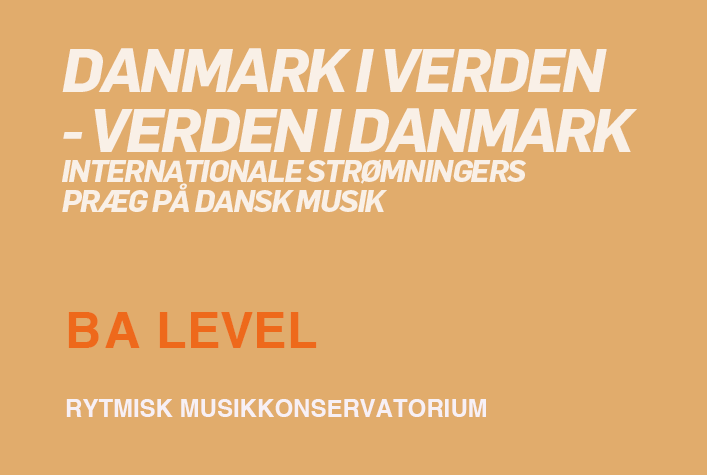
Denmark in the world – the world in Denmark: The imprint of international currents on Danish music
Educator: Henrik Marstal
Contact person: Lene Christensen, lc@rmc.dk
Danish popular music has always been deeply influenced by the impulses emanating from the United States and Great Britain and, to a lesser extent, Germany and Sweden. In that sense, the sound of Danish music throughout history can be said to reflect the sound of changing currents from the great foreign world. But does that mean that Danish music is a dependent entity, a copy? Of course not. In most cases, the currents were absorbed in ways in which a special Danish or ‘homegrown’ approach has ensured that the music has often come to sound like something completely different from the role models.
We will make several reflections on Danish music life from the mid-1960s and take a closer look at how new genres from abroad were absorbed by Danish musicians. The purpose of the module is to investigate how Danish music has come into being in relation to these genres. This will be done with the help of concepts such as cultural appropriation / cultural appreciation, as well as notions of authenticity and of musical Danishness. Matters concerning “originality” vs. “copying” will be touched upon as well.
The students’ own experiences as Danish musicians in an internationalized popular music culture will to a certain extent be sought to be included as a perspective on the module’s investigations.
The module is related to the teacher’s own research on the subject, which amongst other things will result in an upcoming book project on Danish music’s relations to foreign currents.
PREREQUISITES
It is an advantage to have an interest in Danish music and an advantage, but not a requirement, to have a certain knowledge of Danish music history from the 1906s and onwards. The course will be in Danish only.
LEARNING OUTCOMES
By the end of the module, the student will:
- have conceptualized significant currents in Danish music
- have gained knowledge of how international currents are negotiated and domesticated
- have gained insight into the relationship between ‘the Danish’ vs. ‘the foreign’ in Danish popular music
CONTENTS
We will work with the following elements:
- review of selected artists, works, genres
- discussion of theoretical issues concerning appropriation, assimilation and copying
- Danish and English as a language of song
- Danish musicians’ relations to foreign role models
- the concept of musical Danishness and the concept of evasive Danishness (a concept developed by the teacher himself)
LEVEL
BA
TIME
One semester, 2 hours per week, likely on Fridays (not scheduled yet)
ETS
2,5 ETS
TEACHING AND WORKING METHODS
- lectures
- presentations
- text reading
- listening to music
GROUP FORMATION
Usually 8-9 students
ASSESSMENT
The assessment will be made based on a reflection essay (in writing), alternatively a podcast. A self-chosen topic must be explained within the framework of the module’s topics in the form of a reflection essay of 5 standard pages or a podcast with a duration of 10 minutes.
The essay must include a minimum of five source references, of which a minimum of two must be included in the source list for the module. This requirement also applies to podcasts.
Students with a mother tongue other than Danish can submit the assignment in Scandinavian or English. The essay is submitted in WISEflow before the deadline set by the Study Administration.
REFERENCES
Texts and excerpts from various literature will be used, especially taken from cultural theory, history and musicology, including:
- Iben Jensen: Grundbog i kulturforståelse,
- Nadra Kareem Little: A Guide to Understanding and Avoiding Cultural Appropriation
- Bruce Ziff & Pratima V. Rao: Borrowed Power
- Brianna Fragoso: ‘Cultural Appropriation Vs. Cultural Appreciation ‘
- Ulf Hannerz: Transnational Connections
- Søren Hein Rasmussen & Rasmus Rosenørn (eds.): America in Danish cultural life 1945-75
- Morten Michelsen (eds.): Rock in Denmark. Studies in popular music from the 1950s to the turn of the millennium
- Mads Krogh & Henrik Marstal (eds.): Popular music culture in Denmark after 2000
In addition to articles, manuscript extracts and presentations related to the teacher’s own ongoing research.
Music by i.a. Caesar, Povl Dissing, Young Flowers, Gasolin ’, Trille, Pia Raug, Future 3, Mercyful Fate, Aqua, The Crazy Bag, L: Ron Harald, Dizzy Mizz Lizzy and many more will be included as well.
TIME
One semester, 2 hours per week, likely on Fridays (not scheduled yet)
PLACE
Rhythmic Music Conservatory
ONLINE
No
LEVEL
BA
ETS
2,5 ETS
LANGUAGE
Danish
REGISTRATION
If you wish to participate in one of the TVAERS courses, you need to register 1 or 2-course requests.
Before the course start, you will be notified if you can be offered a place on a module.
Registration opens on June 3rd.
The deadline for registration for the fall semester of 2022 is 17 June
You register by this link
